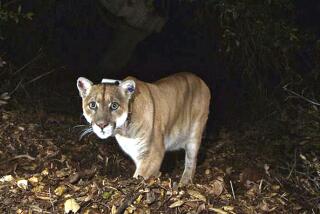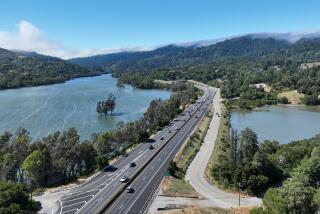Besides Each Other, Cars Take Their Toll on Walkers, Wildlife
- Share via
In the minds of many motorists, an accident means hitting another car or a telephone pole.
But last year in the United States, 5,546 pedestrians were struck dead by cars, and about 96,000 are injured annually.
More injuries and damage were caused when cars hit deer and moose.
Seat belts, air bags and improved energy-absorbing frames have helped cut deaths among occupants of cars, but there are no safety devices to protect pedestrians.
The problem is particularly acute in California, which has a higher than average rate of pedestrian fatalities, said Ray Peck, chief researcher at the California Department of Motor Vehicles.
In 1992, California had 700 pedestrian fatalities--a rate of 2.48 fatalities for each 100,000 residents, almost three times the .83 per 100,000 fatalities in Kansas, the lowest among the 50 states. Nearly half of the pedestrian deaths in California occurred in Los Angeles County.
“We have a lot of traffic here,” Peck said. “Maybe more homeless people, more people walking on highways. So, it doesn’t really surprise me. Where you have a lot of congestion and poverty and pedestrians, you would expect more fatalities.”
Nationally, 70% of pedestrians killed are male and about 40% are drunk, according to data compiled by the Insurance Institute for Highway Safety. But a large proportion of the pedestrian deaths involve children and the elderly, the institute found.
Despite recent declines in pedestrian deaths and vehicle occupant deaths, the rates may again rise as the economy improves.
“Some of the drop we have seen is because of the bad economy,” said Allan Williams, senior vice president for research at the institute. “For reasons we really don’t understand, deaths go down during bad economic times. It may be less recreational driving or less alcohol. We’re not sure. There is a very clear correlation, though, between the unemployment rate and highway deaths.”
The issue of deer and moose collisions is considered a growing problem as urban areas encroach on the wilderness. State studies show that huge numbers of accidents occur with animals, although nobody has done a national study.
Wisconsin has reported 40,000 vehicle accidents involving deer each year, costing $70 million in auto damage. Similar studies in other states put the toll in that same range, indicating a national cost in the hundreds of millions of dollars.
In California, there are no statistics on the number of deer accidents because insurance companies and the state lump them in with miscellaneous claims and other property damage accidents. In 1989, Caltrans estimated that 15,000 deer were killed by motorists in the state, resulting in $15 million in damage to cars.
In California and other western states, deer move to lower elevations in winter, creating a hazard when roads are wet and slippery. Dawn and dusk are the most hazardous times because visibility is poor and the animals are active at those times.
One countermeasure that has attracted attention is the deer whistle, which can be mounted on the side of a car. The device emits an ultrasonic whistle as air passes through it, which is supposed to repel deer. Alert Industries of Agua Dulce is one of the local companies that makes deer whistles.
The Insurance Institute for Highway Safety reported last year that no scientific studies have verified that the whistles work and a University of Wisconsin study concluded deer could not hear them from even 10 meters away.
John Gillotti, vice president of Alert, said those tests were flawed, and that tests conducted for Alert by the University of Iowa validated the effectiveness of the device.
More to Read
Sign up for Essential California
The most important California stories and recommendations in your inbox every morning.
You may occasionally receive promotional content from the Los Angeles Times.














